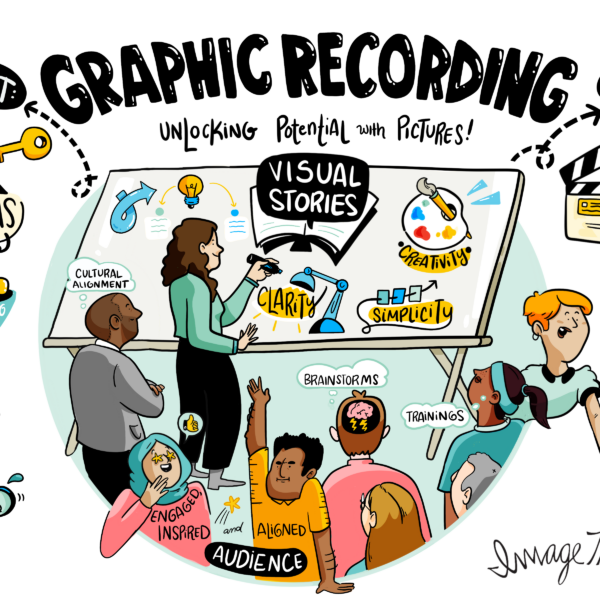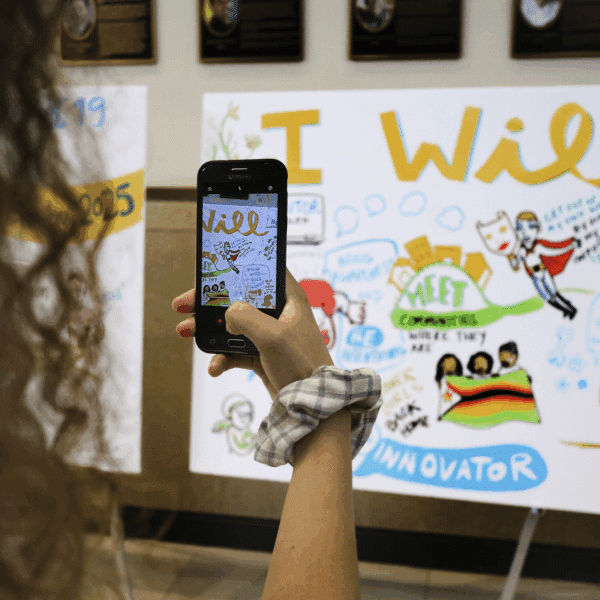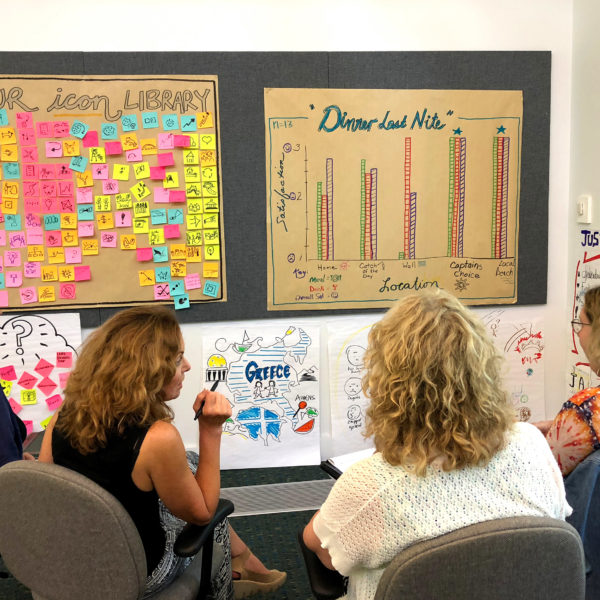What is Visual Strategy?
Visual strategy is the strategic approach of working visually. It combines strategic thinking with visual theory and applications to unlock creative thinking, promote collaboration, and accelerate planning and execution. Visual strategy is the basis of ImageThink’s very own methodology, The ImageThink Method™, which incorporates design thinking principles, gestalt theory, and graphic facilitation.
Visual strategy is the ideology that has underpinned ImageThink’s work, and the strategic approach we’ve used for 15 years. With this proprietary framework, we’ve helped propel organizational initiatives forward, to orchestrate memorable events, and to help individuals, teams, and organizations ideate, communicate, and strategize better.

If you’re…
- …someone who is new to visual strategy and its applications,
- …someone looking to expand their use of visual storytelling, or
- …someone looking to shake up the traditional with a better, more creative approach
You’re in luck! This blog explores visual strategy in more depth, covering who uses visual strategy, the visual strategist’s process, visual strategy examples, and how to incorporate visual strategy into your work. Read on to become well-versed in the strategic approach that’s revolutionizing the way industries and organizations think and work.
Who does Visual Strategy?
While visual strategy can be performed by anyone, there are professionals who have specific training that make them adept at thinking and working visually. Visual strategist is the all-encompassing term assigned to ImageThink graphic recorders, as they are true practitioners of visual strategy. The visual strategist’s process, which involves listening for, synthesizing, and translating ideas is the foundation of visual strategy. However, visual strategy isn’t limited to graphic recorders and graphic facilitators, and artistry is not a requirement of visual strategy. Specifically, anyone who incorporates visual thinking, tools, or exercises into their personal or professional lives is actively practicing visual strategy.
Visual Strategy examples
ImageThink leverages visual strategy in every facet of our work – from graphic recording to graphic facilitation, to strategic visualization. Here’s how:
1. Graphic Recording
Graphic recording is ImageThink’s core service offering and as such, it is the most common way we apply visual strategy. Clients bring us in to provide graphic recording to create clarity out of complex content and messaging, to engage attendees and encourage participation, and to memorialize and document key ideas. Visual strategy aids these efforts by simplifying insight without compromising its integrity and making content inviting and exciting through visual translation.

2. Graphic Facilitation
Graphic facilitation leverages visual strategy in meetings and gatherings, in-person or virtually. ImageThink graphic facilitators use visual strategy in the form of creative exercise, graphic recording, and by applying visual tools to engage teams and help them align to a larger cause.
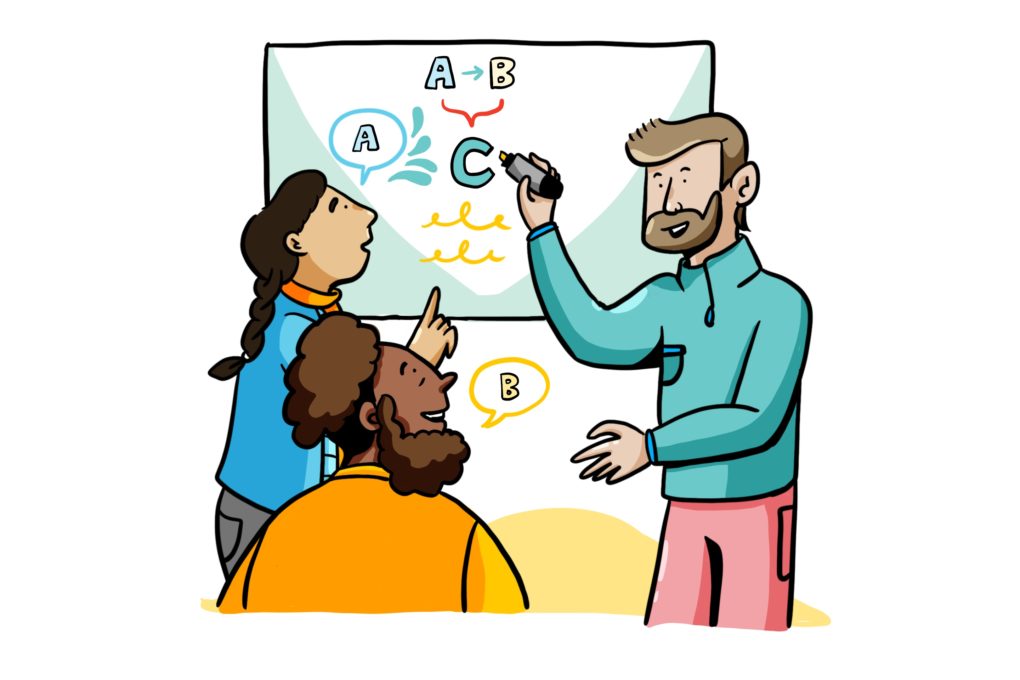
3. Strategic Visualization
Strategic visualization – or ImageThink’s tool for iterative visual storytelling – uses visual strategy as a foundation for telling stories effectively, for maximum impact. Working visually helps us communicate organizational missions, initiatives, and histories in a way that builds engagement and investment. In view of this, without visual strategy, these invaluable pieces of collateral would merely be a history textbook, saved somewhere on the cloud, never to be read, considered, or learned from.

How you can incorporate Visual Strategy into your work
So, you’ve read up on visual strategy, the process of visual strategy, and the tools ImageThink has developed to apply it. Now all there is to ask is, “How can I use it?” Below, we’ve included some visual strategy examples you can incorporate into your work today:
1. Visual Leadership
A good leader aligns teams and organizations, provides direction, and identifies purpose. Critical to your success as a leader is clarity, which is where pictures can help. We call it visual leadership, and it’s how ImageThink helps those in leadership roles leverage the skills, knowledge, and expertise of their organization, unite teams, and chart the path forward.
While hiring a graphic facilitator is the quickest way to exercise visual leadership, you can still leverage visual strategy in a leadership role by using whiteboards, notebooks, sketching apps, and simple diagrams to communicate goals across teams and departments.

2. Brainstorming
Integrating visual thinking into brainstorming and ideation sessions is a low lift way to incorporate visual strategy into your work. Undeniably, adding visual elements or creative exercises turns dull meetings into vibrant innovation hubs, allowing attendees to tap into creative thinking. In addition to the idea generation and expansion of ideas, incorporating visual strategy into these sessions aids collaboration and decision-making.
At the very least, all that is required to incorporate visual strategy into your brainstorms is a writing tool. However, a white board and post-it notes are sound tools for visualizing, developing, and organizing information.
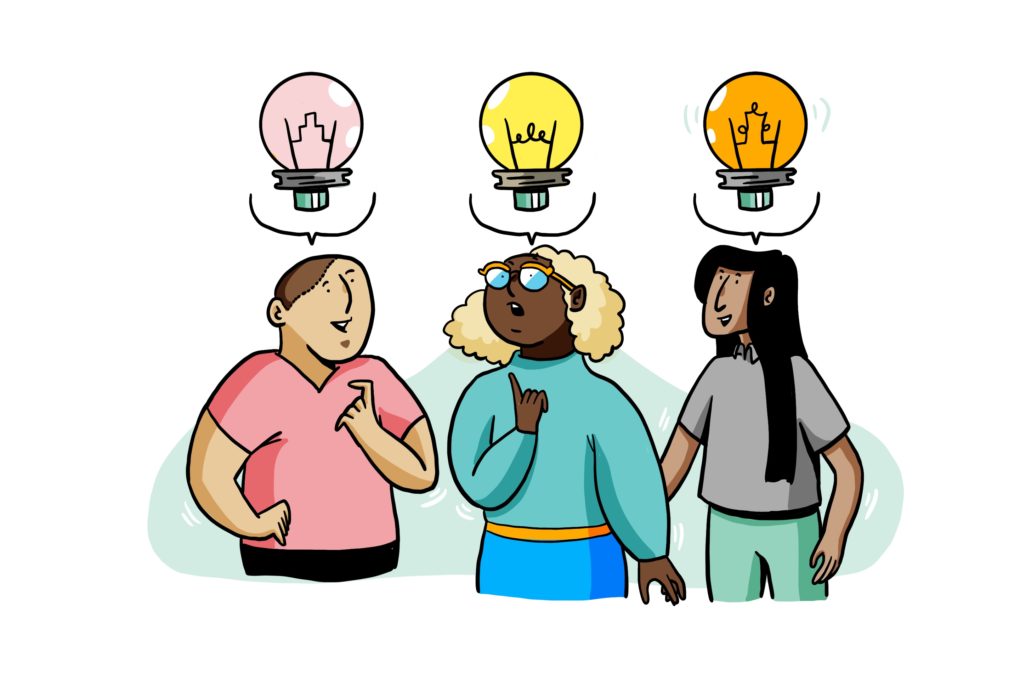
3. Visual Communication
Whether it’s for marketing collateral or cross-department communication, visual strategy makes communication instantly more memorable and engaging. It’s not rocket science, it’s brain science: our brains are wired to favor visuals over any other medium.
Leveraging visuals in organizational external and internal communications is a guaranteed way to add impact to overall communication with teams. It also creates alignment around work processes and developments.

Whether you’re sketching out and expanding upon ideas on a white board, or using visuals to craft and spread your message, visual strategy will act as your compass, guiding you toward unparalleled success in each endeavor.
To begin applying visual strategy examples today, get in touch with us at (347) 735-9620 or by contacting us here.
